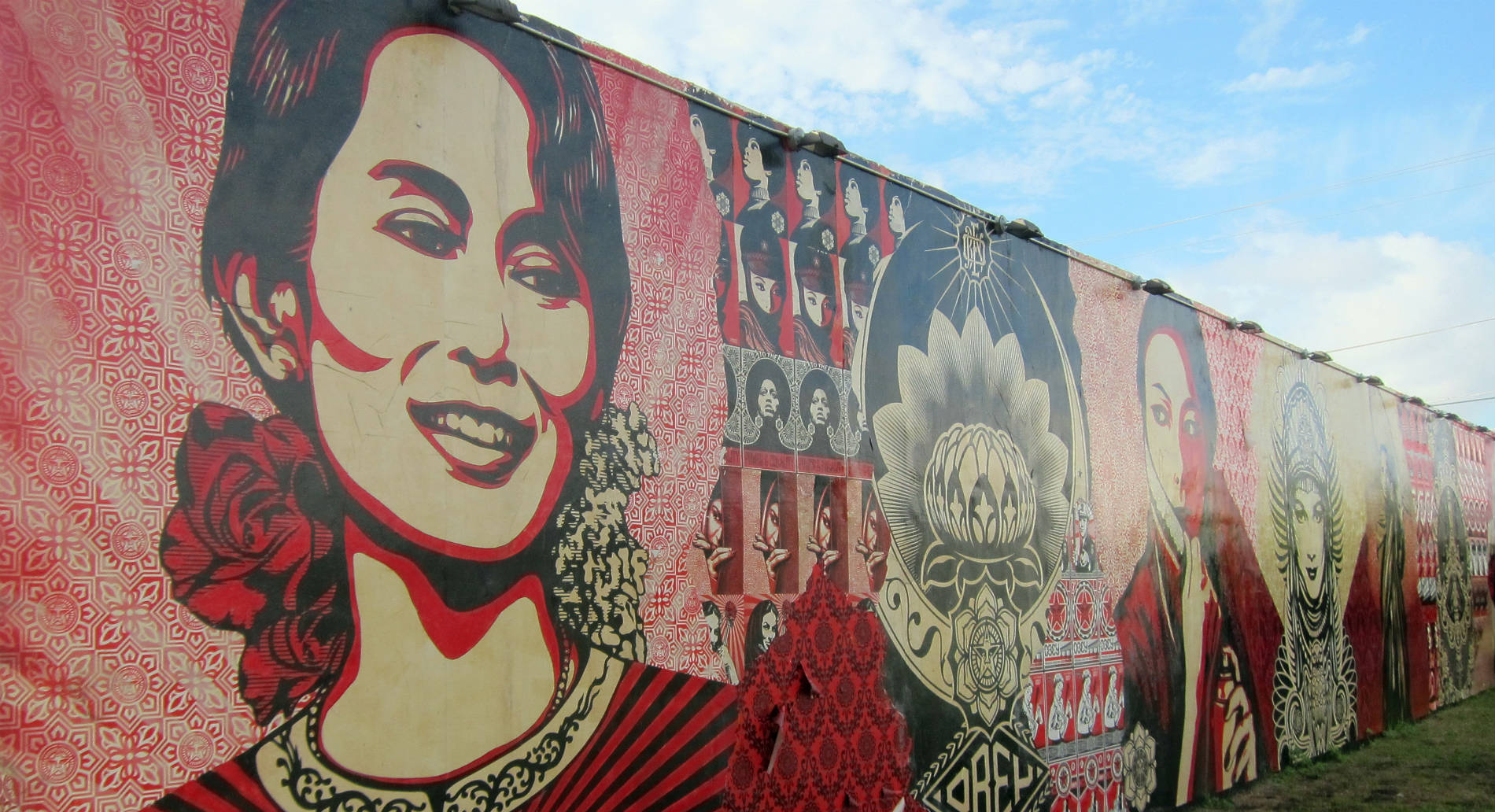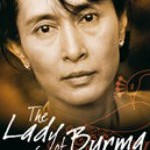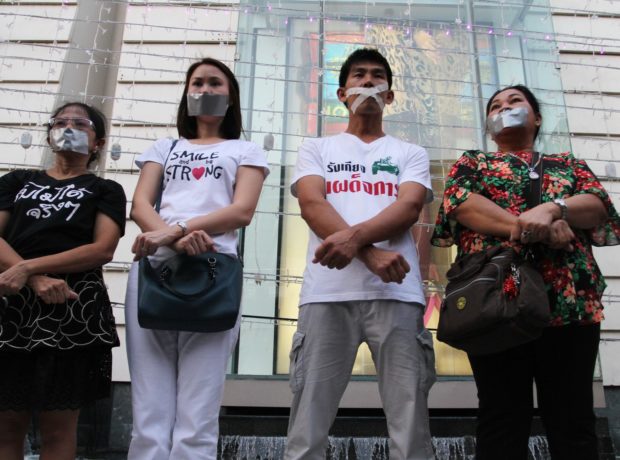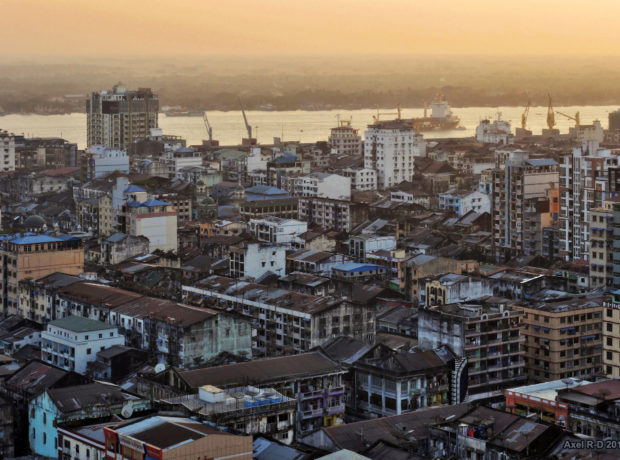The playwright Richard Shannon tells the story of the birth of his celebrated play The Lady of Burma, about the life of Aung San Suu Kyi, and how art and a campaign against injustice can interact in meaningful and effective ways.
‘Reality has to be altered by being turned into art, so that it can be seen to be alterable’ — Bertolt Brecht
To attempt to use a play to advocate a cause is fraught with dangers. If the cause and its political detail form the engine of the drama, I believe it will fail. It will fail as theatre because it will only engage the head and not the heart. If the intention is to provoke action, on whatever scale, it is vital that the issues are embodied in character and played out in action on the stage. The audience needs to find a way of entering the story and this requires empathy with the protagonist or the group fighting oppression.
At the premiere of my play The Lady of Burma, Maureen Lipman said, ‘Humanising a political crisis is the best way of bringing it to the people.’ This was my guiding principle throughout the process of writing the play.
So what provokes any writer to write a play? A commission, a feeling, a story? Sometimes the impulse comes from a totally unexpected place and moment.
In 2005, I was working as the Associate Director of Polka theatre for children. We were mounting a new writing festival called ‘Playgrounding’. The work was extraordinary. One of the most arresting pieces was a play about the Vietnamese boat people. It was directed by Scot Graham of Frantic Assembly, a hugely innovative UK theatre company. It was poignant and poetic and the lead actress, Liana Mau Tan Gould, was exceptional.
I wanted to congratulate Liana on a moving performance and so we met for coffee. In the course of conversation, I was struck by her resemblance to Daw Aung San Suu Kyi. I asked if she’d heard of the Burmese democracy leader, but she shook her head. I then said, without any notion of a plan, that I would write a play about Daw Suu and asked if Liana would play her. There was no money, but would she do it? Without hesitation she said ‘yes’. It was the first step on a journey that would lead to the creation of The Lady of Burma.
Having made this commitment, I was forced to work out exactly what it meant. If I’d really examined the challenge, I may not have continued, but my naivety proved a strength.
My first move was to contact Vera Baird MP, who chaired the All Party Burma Group in the House of Commons. I emailed her to ask what she thought of the idea. She replied the same day: ‘It’s not been done, get on with it.’ This was the second act of permission and led directly to my contacting Burma Campaign UK (BCUK). It so happened that my dramaturge at Polka Theatre, Frauke Franz, was a good friend of Tina Temple-Morris, Events Director for BCUK. Tina came to visit me at Polka and after a series of meetings I was able to convince Yvette Mahon, director of BCUK, that the play would not only raise Daw Suu’s profile, but also raise money for the Campaign.
The question then became: when and where to stage the play? Another personal connection proved critical.
At the time, I was directing Bear Stories by Martin Waddell at Polka. My designer was Polly Sullivan and Polly was a good friend of the administrator of the Old Vic. She’d also agreed to design the play. Polly set up a meeting with the Old Vic and the management agreed to give us the theatre at a large discount for a gala evening.
I have no idea to what extent Kevin Spacey was involved in the decision, but I imagine he gave it his blessing. We were to perform on his set of the Moon for the Misbegotten by Eugene O’Neill. This was in April 2006, and the date set for the gala was 12th November of the same year. I had yet to write a single word.
From the moment BCUK had backed the idea, I’d been researching. My first trip was to Blackwells on the Charing Cross Road, where I bought a copy of Freedom from Fear – a collection of Aung San Suu Kyi’s speeches and letters. I wanted the play to reflect not only her thoughts, but her speech rhythms. I read everything I could lay my hands on, but as yet, hadn’t met anyone who knew her. This was my next task.
Dr Anne Pasternak-Slater had been a close friend of Suu’s at Oxford and I managed to set up a meeting at St. Anne’s, where she teaches. The details gleaned at this meeting were illuminating, but only covered her time at university. I needed much more on her life as a child and as a mother. BCUK put me in touch with her sister-in-law, Lucinda Phillips. At first, she and other members of the family were highly suspicious of my motives and reluctant to engage in anything that might connect Suu to the West and so damage her in Burma. Over time, however, I was able to convince them that the project was worthwhile and that I would not include any material that might expose Aung San Suu Kyi to criticism or reveal sensitive private information. They agreed to allow access to private letters and family videos.
The first draft was no more than a political rant. The voice was much more mine than hers, there was no shape, but at least it was a start.
My picture of Suu was becoming much clearer. Box files of material now had to be transformed into a play. I started to write. The first draft was no more than a political rant. The voice was much more mine than hers, there was no shape, but at least it was a start. I needed to make much faster progress and above all I needed time to focus on the writing. With excellent timing, the playwright and critic, Brian McAvera offered me a week’s writing time away from the family, at Stranmillis College in Belfast. The opportunity was to mark the key turning point in the development of the text.
My first attempts to write were extremely frustrating. I still couldn’t find the structure or the voice and most importantly, the emotional life of my central character. This was key to the whole project. I was determined to explore the human being behind the polished political mask. The play had to create genuine empathy for Suu. I was certain that if I could do this, the play would not simply raise her profile and encourage reflection, but provoke action from its audiences.
After a week of increasingly arid drafts, I made the crucial break through: I wrote the scene where Suu’s mother dies. In the process, I was brought back directly to the death of my grandmother. My grandparents raised me, and her death had a profound impact on me. Out of an abiding sense of sorrow, my version of Suu’s grief was born:
Extract from The Lady of Burma
Mother…mother was a little better, you know.
I had been able to move her back to the house and I knew this had helped.
But time was…slipping away.
Suu enters the memory, sharing it with the audience
Christmas is over – A few bizarre neon displays set up in hotel lobbies – the reindeer, the father Christmases – are still twinkling in bright sunlight.
I had had enough of party business and come home early.
The sun is setting and the whole house is suffused with red light – I see that the door is open.
Maung Htoo, is sweeping leaves from the steps.
He points wordlessly into the darkness of the house.
I leave my briefcase on the veranda and go inside.
The only sounds – the ticking of the clock, the gentle lapping of the water on Inya lake and the cicadas.
I go to her room.
Light from a window – throws a shaft across the hall and slides under her door.
I don’t want to go through that door. I don’t want to see.
Then I am sitting by her bed.
Her face is as pale as a paper lantern.
I hold her hand. It is so cold.
Thin strands of white hair have fallen across her eyes and gently… … gently, Aung San Suu Kyi’s fingers re-enact this moment…
….I put them back into place.
As I child I would walk round and round her bed and ask her a question every time I got to her feet.
She was exhausted after standing all day on the wards, but she never once…not once, refused to answer me. And now. She cannot answer me.
Not a single word.
I get to her feet and they are as cold as ice.
The tea beside her bed is cold. Stone cold on the table.
She looks asleep.
And her face, for the first time, is in repose. As if all the tension in her body has drained away – I look for the gentle rise and fall of her breast.
It is still.
I bend low over her head – hoping, hoping to feel the slightest movement of air. There is nothing. She is gone.
I close the door and sit beside the bed, alone in the dark.
By the time I finished this scene I had also decided the play had to be a one-woman show – not only to minimise the cost, but also to underline her isolation. This presented a series of challenges: how could she speak to other characters? How would speaking to herself be credible?
The second question was resolved when I decided to set the play in a hospital cell in Insein prison. She is alone and recovering from the assassination attempt at Depayin in 2003. The location and this event were dramatically valuable: it allowed her space and time to reflect on the terrible event where 100 of her young followers were beaten to death; and it allowed her to talk to herself and to other characters she remembers. I decided she would talk to the dead too, her mother and her husband, Michael Aris. I’d been told that Suu is a great mimic and enjoys imitating people for comic effect. This gave me permission to allow my version of Suu to embody a range of other characters, from her gardener to General Than Shwe. Now I was able to break down the image of the political figure and reveal more of the human being.
My portrait of Suu was taking shape. But I still needed to know much more about the events of the 1988 uprising, which initiated her political engagement. BCUK introduced me to one of the former students who had led the protests, Ko Aung. I met Ko Aung in a cafe in the British Library. It proved to be a very emotional interview. Ko Aung had been present at the massacre in the square in front of the Town Hall in Rangoon and as he recounted his experience, we were both reduced to tears. Every detail of the massacre in the play is based on his eye witness account:
Extract from The Lady of Burma
In the distance, they hear the thrum of engines and the clank of caterpillar tracks – plumes of dirty diesel smoke puncture the air as the tanks and armored cars close off all the exits to the square.
But he tells them. He tells them they can go. One street is still open.
Go now. If you want to. Go.
But most stay. Sitting. Waiting.
Then from behind the vehicles – the rapid clatter of boots – and soldiers now form a solid dark green barrier across every junction.
The students are trapped.
The sun glints on the bayonets.
No one moves.
Nothing moves.
The sun shines.
Then someone…no-one knows who – begins….
The students chant
Pi du seta – do seta
People’s Soldiers! People’s Soldiers!
Don’t shoot! Don’t shoot!
Over and over – till the rhythmic cry fills the air.
The young man sitting on my porch stops. His voice falling to a whisper.
His sister, a girl of 14 – she had followed him from home – suddenly she grabs his flag – his red fighting peacock – and runs – Runs right towards the nearest tank.
Suu takes the blanket and it becomes the flag of the revolution
And up – onto the turret and planting her banner on the tank she shouts at the top of her voice:
The young girl cries out in Burmese
People’s Soldiers! Don’t shoot!
You are our brothers – you are our brothers!
She is shouting into the face of a young soldier – his hand closes on the trigger of the machine gun, fixed to his turret.
There is a moment of silence.
The machine gun burst
She takes it full in the chest and flies backwards through the air.
Her body hits the ground – dead – like a rag doll.
Then the square fills with firing. From all sides. Slowly and with deliberation, the soldiers advance – bayonets finishing what the bullets had begun.
The young man’s eyes are empty –
He tells me he got to his sister.
She lies perfectly still in a crimson pool.
The blanket has now become the body of the girl
He ties his red fighting peacock headband to her head.
All around him, people are falling. He holds her body.
He would have remained there and died, had not a fellow student pulled him away.
Pulled him away as far as a tree on the edge of the square.
He cannot bring himself to leave, but climbs high into the tree and hides in its dense foliage.
What he sees then – what he witnesses…..
Once the soldiers had bayoneted the square, the bodies are collected – the dead – the barely living – and thrown onto trucks and taken – as I later discovered – for incineration.
Then fire engines come and hose away the blood.
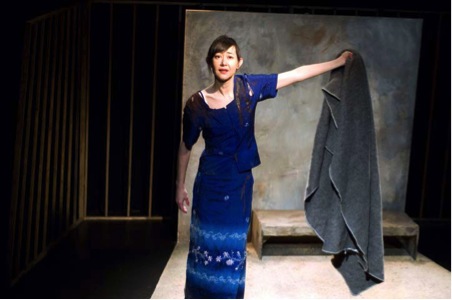
Photo by Geraint Lewis 2007
Despite all the information I had accumulated, I was still nagged by doubts of credibility. I was not Burmese. I’d taken no part in the struggle. I hadn’t been involved in the BCUK campaign. Although I believe an artist has the right to inhabit any character or situation, I still felt I needed more authority to complete the work. My reservations were compounded by Rachel Goldwyn, a pro-democracy activist. She had been imprisoned for protesting against the regime in Rangoon and was only released on condition that she made no further critical comments. When I spoke to Rachel to discuss her experiences, she asked me if I had been to Burma. When I said ‘no’, she challenged me, asking how I could write a play about Burma without going there. Up to this point, I hadn’t considered this possible – lack of money being the main problem. Rachel’s question forced me to revisit the issue. I resolved to go and decided to apply to the Arts Council (England) for the money. They awarded me a grant, which also enabled me to employ two dramaturges to support the writing of the final draft: Paul Sirett and Hanna Slattne.
The trip was extraordinary. I experienced a palpable sense of the fear, oppression and poverty that existed in Burma. Although the trip did not alter the play fundamentally, it added vital colour and detail. Most crucially it gave me the confidence to advocate the work publically.
The next stage was to test the text in front of a live audience before the gala performance at the Old Vic. I contacted St. Hugh’s College, Oxford – Suu’s alma mater. They readily agreed to host a reading in mid-October 2006. It was an incredibly nerve wracking experience. As the room filled up with academics and students, including people who had known Suu, I became increasingly anxious. This was the first real test of the script.
The initial fifteen minutes were agony. I felt the play was too wordy, self-consciously literary and frankly, boring. Then suddenly it started to work.
The initial fifteen minutes were agony. I felt the play was too wordy, self-consciously literary and frankly, boring. Then suddenly it started to work. I could feel the audience engaging and by the end I knew it had the potential to succeed. Paul Sirett came up to me and said: ‘cut the first fifteen minutes, do one more draft and this is going to work!’
My actress, Liana, then had the enormous task of learning the whole text. But she came wholly prepared and after an intense week of rehearsal, we were ready for the Gala performance at the Old Vic on November 12th.
The theatre was completely sold out. BCUK had managed to fill the second half of the evening with speeches from key supporters including Annie Lennox, Neil and Glenys Kinnock, Maureen Lipman and Prunella Scales. Zoya Phan of the campaign also spoke.
The whole event was a huge success. Liana received a standing ovation. We raised over £30,000 and many people signed up to join BCUK. The Independent said: ‘Rarely is a show so powerful’.
So, the project achieved its primary objective. I had written it for this one event, but part of me hoped that it would have a future life. Right then, I didn’t know how.

Photo by Geraint Lewis
Paul Sirett told me that I had to meet Louise Chantal. Louise hadn’t seen the performance, but she had read the text. She was a very experienced producer with a real passion for plays that addressed issues of social justice. She had recently produced The Exonerated, an intense play about death row in the USA, at the Riverside Studios. I met Louise full of trepidation and convinced I would have to try to sell the play. I didn’t need to – she had already decided she wanted to produce The Lady of Burma and take it to the Edinburgh Festival in 2007. This was the key moment that extended the life and impact of the play way beyond the one night at the Old Vic.
The run at the festival was a triumph. Louise approached James Seabright to co-produce the play for a national tour. Before the tour started, Burma was suddenly in the headlines – monks were marching and protesting against the Junta. The Saffron Revolution was underway. This extraordinary confluence of art and politics meant that a major London venue, the Riverside Studios, was suddenly keen to run The Lady of Burma. The production played to sell-out houses for three weeks. The critical reception was extraordinary. Sam Marlowe in the Times wrote: ‘Personal and political have rarely been so ferociously connected’.
Liana went on to tour the play nationally in 47 venues over the course of a year. At each performance a bucket collection for the BCUK was made. The money collected ran into thousands of pounds. The play was revived for the Brighton Festival in 2011, directed by Owen Lewis. Aung San Suu Kyi was appointed guest director for the Festival and her image filled Brighton.
Since 2006, the play has been translated and produced in Norway, Ireland, Bangalore and Poland. In Bangalore it was re-imagined as a Kathakali sytle dance drama. Negotiations are currently underway to remount it in Norway and a Korean translation has been commissioned. In January of this year, I discussed the possibility of the play being performed in Burma, given the reform process. Kevin MacKenzie, director of the British Council in Rangoon, made it clear that it was too early and as Aung San Suu Kyi is to stand in next year’s election for President, it could damage her campaign. We agreed to discuss it again after 2015.
Perhaps the most extraordinary manifestation of the text was a performance at the Burmese Arts Festival that I helped to organise at the Free Word Centre, London, in 2010.
The play was performed by the Burmese Theatre Workshops – a company made up of young Burmese students and exiles. They adapted the one woman show into a multi-character play and at the very end, Aung San Suu Kyi was lifted up with a halo of brightly coloured lights, transformed into a living Buddha.
So, how can writing for justice have an impact in the real world? As Brecht said:
Reality has to be altered by being turned into art, so that it can be seen as alterable’.
Artists need to have faith that small actions can, over time, have larger consequences. Although I can make no provable claims for the impact of the play, when I met Aung San Suu Kyi at the Speaker’s House in 2012, she said the play had shone a light on injustice in Burma at a time when it was forgotten.
Apart from performance to the general public, the play has also been performed to politicians, presenting the issues to those unfamiliar with Burma and providing BCUK with a focal point for lobbying. The play was produced at the Speaker’s House (UK Parliament) in October 2010, before Aung San Suu Kyi’s release from house arrest and also presented at the European Parliament in the same month. It served to open other doors too. In 2009 I was able to persuade the Royal Society of Arts to give Aung San Suu Kyi an Honorary Fellowship. An extract from the play was performed at the ceremony and again, a small group of opinion formers was exposed to the issues in Burma.
The national tour and even the productions in translation could only reach an audience numbered in thousands. I was keen to find ways of using the play to reach a wider audience and also to keep momentum going. I suggested to BCUK that we should try to organise a global reading of the play to mark Aung San Suu Kyi’s birthday on June 19th. The idea was taken up in many countries in 2008. Most interestingly some individuals broadcast the reading on radio. In 2008 I recorded the play for radio and CD, and copies were sold on the tour.
With the release of Aung San Suu Kyi in 2010, the journey of the play came to an end. Democratic change in Burma is only just beginning. In 2012 Aung San Suu Kyi called on British universities to get involved in rebuilding Burma’s Higher Education system. As an Associate Lecturer at Goldsmiths, University of London, I saw an opportunity to extend my attempt to assist change in Burma. In January of this year, I organised a conference which was addressed by the director of the British Council in Rangoon, Dr Marie Lall from the Institute of Education and Dr Celia Russell and Ms Yin Min Tun from Manchester University. The college is now sending Mr Gerry McColloch to Burma to start liaising with Burmese academics and artists. It hopes to establish academic collaborations and to offer doctoral scholarships.
I am certain that any credibility I have with regard to Burma and hence my ability to encourage others to take positive actions to assist the Burmese people, is entirely built upon my work with The Lady of Burma. In this way, art and political action have found a genuine synergy. Writing for justice can help to tip the balance in favour of justice.
Photo by wallyg ![]()
![]()
![]()
